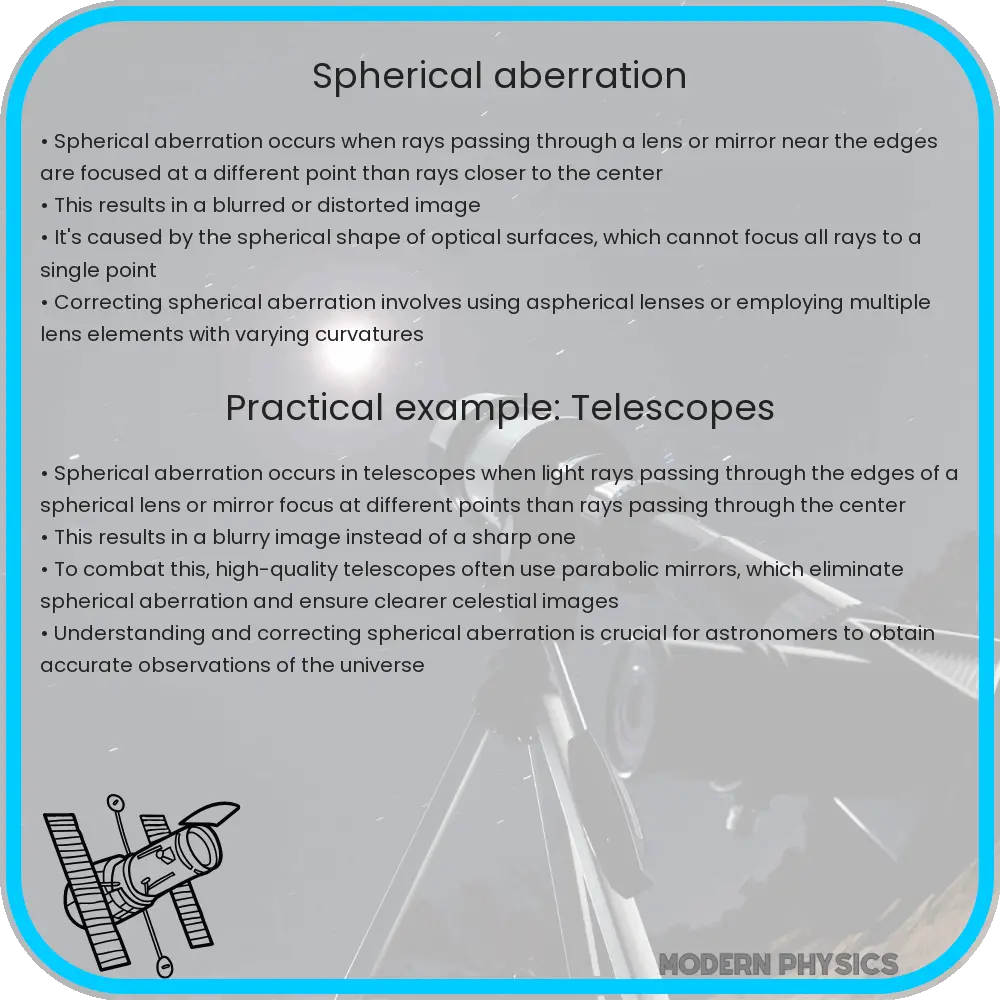Explore the causes, effects, and advanced correction methods of spherical aberration in optics, enhancing image clarity in scientific and visual equipment.

Understanding Spherical Aberration in Optics
Spherical aberration is a common issue in optical systems where light rays passing through a lens or mirror converge at different points, leading to a blurred or distorted image. This phenomenon occurs when light rays refract or reflect off spherical surfaces, a characteristic of many lenses and mirrors. Understanding the causes, impact, and correction of spherical aberration is crucial for improving the quality of optical devices like telescopes, microscopes, and cameras.
Causes of Spherical Aberration
The primary cause of spherical aberration lies in the geometry of spherical lenses and mirrors. When light rays enter a lens near its edge, they are refracted more than rays closer to the center. This difference in refraction causes the rays to focus at varying distances, creating a blurred image. The same principle applies to spherical mirrors, where the curvature causes light rays to reflect at different angles.
Impact of Spherical Aberration
Spherical aberration can significantly impact the performance of optical systems. In imaging devices, it leads to a loss of detail and sharpness, affecting the overall quality of the image. In scientific instruments like telescopes and microscopes, spherical aberration can limit the resolution and accuracy, hindering observations and measurements. This aberration is particularly problematic in high-precision applications where clarity and detail are paramount.
Correction of Spherical Aberration
Correcting spherical aberration is essential for enhancing the performance of optical systems. There are several methods to achieve this:
- Use of Aspherical Lenses: Aspherical lenses, which have a non-spherical shape, are designed to focus light rays more accurately, reducing spherical aberration.
- Aperture Limitation: Reducing the aperture size of a lens can minimize the impact of spherical aberration by limiting the range of angles at which light enters the lens.
- Lens Combinations: Combining multiple lenses with different curvatures can counteract the effects of spherical aberration.
- Software Correction: In some cases, post-processing software can be used to correct the distortions caused by spherical aberration in digital images.
Each of these methods has its advantages and limitations, and the choice often depends on the specific requirements of the optical system.
Advanced Methods for Correcting Spherical Aberration
Further advancements in technology have led to more sophisticated methods of correcting spherical aberration:
- Wavefront Analysis: This technique involves analyzing the light wavefronts exiting the optical system. Adjustments are made based on these wavefronts to correct aberrations, leading to higher precision in optical instruments.
- Gradient Index Optics: These are lenses with a gradual change in the refractive index within the material. This gradient helps in focusing light rays more effectively, thereby reducing spherical aberration.
- Adaptive Optics: Commonly used in astronomical telescopes, adaptive optics involves dynamically adjusting the mirror shape to compensate for spherical and other aberrations in real-time.
The Role of Material and Design in Preventing Spherical Aberration
Material choice and optical design also play a crucial role in minimizing spherical aberration. High-quality materials with low dispersion rates reduce the spread of light wavelengths, leading to clearer images. Innovative design approaches, like hybrid aspherical elements, combine the benefits of different materials and shapes to optimize performance.
Conclusion
Spherical aberration, a fundamental challenge in optics, arises from the inherent geometry of spherical lenses and mirrors. Its impact on optical systems is significant, leading to blurred and distorted images which can impede scientific research and reduce the quality of visual equipment. Thankfully, a variety of methods exist for correcting this aberration, ranging from the use of aspherical lenses to sophisticated adaptive optics and wavefront analysis techniques. These advancements highlight the ongoing evolution in optical technology, emphasizing the importance of precision in design and materials. By understanding and addressing spherical aberration, we can enhance the capabilities of optical instruments, pushing the boundaries of science, exploration, and photography.
